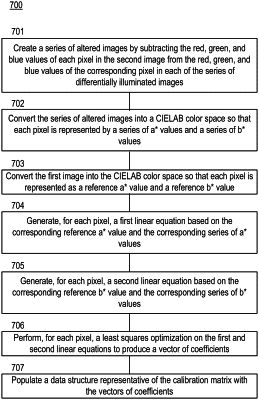| CPC H04N 23/88 (2023.01) [H04N 23/125 (2023.01); H04N 23/56 (2023.01); H04N 23/60 (2023.01)] | 12 Claims |

|
1. A method for calibrating an electronic device with an image sensor, the method comprising:
capturing a first image of a scene having at least one known reflectance spectrum over a first exposure interval with an automatic white balance (AWB) setting;
capturing a second image of the scene over a second exposure interval different than the first exposure interval with a fixed white balance (FWB) setting;
capturing a series of differentially illuminated images of the scene with the FWB setting;
computing a calibration matrix based on the first image, the second image, and the series of differentially illuminated images by
creating a series of altered images by subtracting the red, green, and blue values of each pixel in the second image from the red, green, and blue values of the corresponding pixel in the series of differentially illuminated images,
converting the series of altered images into a CIELAB color space so that each pixel is represented by a series of a* values and a series of b* values,
converting the first image into the CIELAB color space so that each pixel is represented as a reference a* value and a reference b* value,
forming, for each pixel, a system of linear equations that includes
(i) a first linear equation based on the corresponding reference a* value and the corresponding series of a* values, and
(ii) a second linear equation based on the corresponding reference b* value and the corresponding series of b* values,
performing, for each pixel, a least squares optimization on the first and second linear equations to produce a vector of coefficients, and
populating a data structure representative of the calibration matrix with the vectors of coefficients; and
storing the calibration matrix in a memory accessible to the electronic device.
|